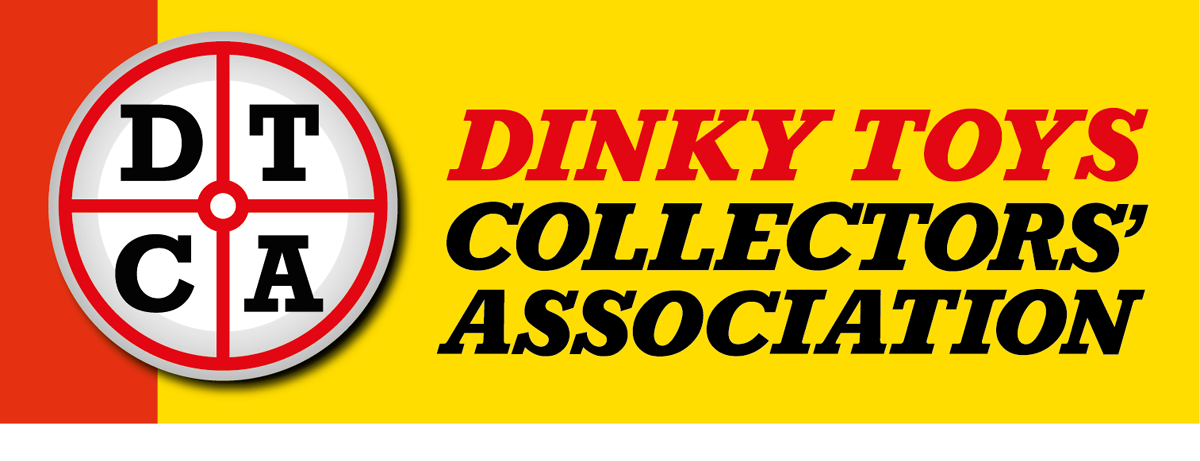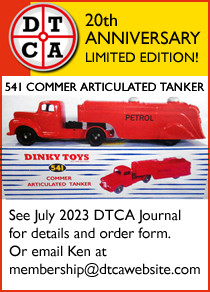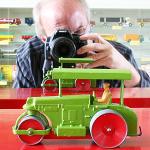-997 Caravelle SE 210 Airliner (1962-1965)
The dies for the French no. 60F S.E. 210 ‘Caravelle’ were temporarily in use in the Liverpool factory, some time in the period 1961-1965. Bearing the number 997 and under the name ‘Caravelle SE 210 Airliner’ this now British Dinky Supertoy fitted nicely within the range of bigger British aircraft models, preceding no. 998 Bristol Britannia Airliner and no. 999 D.H. Comet Airliner. As the numbers between 992 (Avro Vulcan Delta Wing Bomber) and this trio have never been used one may wonder what aircraft models Meccano could have had in mind filing that gap (only briefly – 1954/55 – interrupted by a no. 994 for the separate loading ramp for 982). The Caravelle was announced as ‘NEW’ in the first MM issue of 1962. The die for the lower half underwent some small changes and different transfers were applied. For some specific parts, like the wheels, the British made use of available British parts.
Some differences of the British-made Caravelle as opposed to the original French product:
Nose and elongated transfers on both sides of the fuselage are finished in a darker shade of blue.
Background of the elongated transfers, as visible through the slightly smaller windows, is in blueish turquoise (instead of white/transparent).
The ‘Caravelle’ name on both sides behind the cockpit, as present on the Bobigny product, is wanting on the Liverpool version.
‘AIR FRANCE’ is printed in bolder capitals and the tricolore is without frame and in lighter shades of red and blue (in fact turquoise).
The blue tail flash is almost straight, as opposed to the elegantly curving French one.
Registration number F-BGNY in blue, in one, on the starboard wing (instead of divided over both wings – F-B / GNY – and in black).
The wheels of the landing gear are slightly smaller and made of the same wear prone metal as the other British aeroplanes, whereas the French use the more stable darker finished kind of metal. The final British Caravelles of 1965 had black plastic wheels.
The small riveted covers for the landing gear attachments are made of shiny metal instead of the grey metallic body finished ones on the French one.
‘Made in France’ below the starboard wing has been replaced by ‘Made in England’.
The old French number 60F has always remained in place but the British reference number ‘997’ has been added under the port wing tip.
The air intakes for the engines seem to show different front intake details every now and then, but this may rather be due to the functioning or wear of the die of the engines unit than to a deliberate change of that die in my opinion.
Some British examples have a paint spaying hole underneath, others don’t (like the one shown here).
Obvious is the different box, in the contemporary British all-yellow colour, with an airport scene and hinged gangway demonstration detail. Sue Richardson mentions a striped Supertoys box, but I haven’t seen one. Did others?
Inside the box there should be a wrap-around packing piece (not present in this box), whereas the French box has a kind of ‘nose holder’ in one corner in order to keep the model in place.
As far as I know the British one lacks the little paper instruction sheet, which is present in the French box (it explains the functioning of the hinged gangway in the back below).
More information about this model in: Sue Richardson, Diecast Toy Aircraft, an international guide (1997); Geoffrey R. Webster, Dinky Toys Aircraft, 1934-1979 (2010); Claude Wagner / Jacques Dujardin, French Dinky Toys Aircraft (2013).
Kind regards, Jan








-073 Land Rover, Horse Box and Horse (1960-67)
DTCAwebsite upgrade 2023
DTCAwebsite upgrade 2023
-105c and 383 4-Wheel Hand Truck (1949-1958)
-105c and 383 4-Wheel Hand Truck (1949-1958)
DTCAwebsite upgrade 2023
DTCAwebsite upgrade 2023
DTCAwebsite upgrade 2023
DTCAwebsite upgrade 2023
DTCAwebsite upgrade 2023
DTCAwebsite upgrade 2023
DTCAwebsite upgrade 2023
DTCAwebsite upgrade 2023
DTCAwebsite upgrade 2023
DTCAwebsite upgrade 2023
DTCAwebsite upgrade 2023
DTCAwebsite upgrade 2023
DTCAwebsite upgrade 2023
--22c Motor Truck (1933-50)
--22c Motor Truck (1933-50)
DTCAwebsite upgrade 2023
DTCAwebsite upgrade 2023
Trailer Caravans
Trailer Caravans
DTCAwebsite upgrade 2023
DTCAwebsite upgrade 2023
DTCAwebsite upgrade 2023
DTCAwebsite upgrade 2023
Trailer Caravans
Trailer Caravans
-138 Hillman Imp (1963-73)
-537 Renault 16 TL
-189 Triumph Herald Saloon (1959-64)
-255 Mersey Tunnel Police Van (1955-61)
DTCAwebsite upgrade 2023